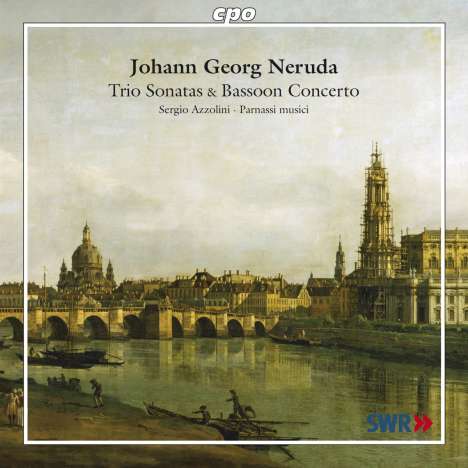Johann Baptist Georg (Jiri) Neruda: Triosonaten Nr.2,4-6 auf CD
Triosonaten Nr.2,4-6
Herkömmliche CD, die mit allen CD-Playern und Computerlaufwerken, aber auch mit den meisten SACD- oder Multiplayern abspielbar ist.
Lassen Sie sich über unseren eCourier benachrichtigen, falls das Produkt bestellt werden kann.
(Nr. 2, 4, 5 für Violinen, Cello, Cembalo; Nr. 6 für 2 Violinen, Cello, Cembalo, Laute)
+Concerto C-Dur für Fagott, 2 Violinen, Viola, Bc
- Künstler:
- Sergio Azzolini (Fagott),Parnassi musici
- Label:
- CPO
- Aufnahmejahr ca.:
- 2007
- UPC/EAN:
- 0761203738328
- Erscheinungstermin:
- 21.7.2008
Ähnliche Artikel
Nach seiner Ausbildung in Prag spielte der böhmische Komponist Neruda zuerst im dortigen Theaterorchester. 1750 wurde er Violinist, später war er bis 1772 Konzertmeister der Dresdener Hofkapelle. Die Triosonaten boten für Neruda eine Gelegenheit, seine »galanten und gefälligen Gedanken« in einer bei Liebhabern sehr verbreiteten Form zu präsentieren: Kurze Motive in allerlei Abwandlungen und Wiederholungen bilden mit dem schwungvollen Themenkopf am Anfang jeder Sonate wesentliche Erkennungsmerkmale des galanten Stils, der sich auch in dem Fagottkonzert wiederfindet.
Product Information
Neruda’s Galant Style
The members of Parnassi musici, performing on a high musical level on historical instruments, are always good for surprises and innovative programs. On their new CD they interpret four trio sonatas and a bassoon concerto by the Bohemian violinist, conductor, and composer Johann Baptist Georg Neruda, who was born in Prague around 1707. After receiving his education in Prague, Neruda initially performed in the theater orchestra there. He earned increasing recognition as a violinist and conductor on his concert tours and became a violinist in the Dresden court ensemble in 1750 and its concertmaster in 1772. He composed eighteen symphonies, fourteen instrumental concertos, twelve trio sonatas, sacred music, and an opera entitled Les Troqueurs. The trio sonatas offered Neruda an opportunity to present his »galant and pleasant ideas« in a form very widespread among eighteenth-century friends of music: short motifs, manifoldly transformed and repeated, together with the animated theme head at the beginning of each sonata, form the trademark features of the galant style, with this style also stamping the bassoon concert. Sergio Azzolini, who has become one of the internationally most sought masters on his instrument, performs on the baroque bassoon.
Rezensionen
klassik-heute.com 12/08: "Sergio Azzolini, ein Meister seines Faches, ist ein grandioser Anwalt dieses schönen Werkes; er spielt mit herrlicher Delikatesse und lässt Töne aufblühen."Disk 1 von 1 (CD)
Sonate für Trio Nr. 4 C-Dur
-
1 1. Vivace
-
2 2. Andante
-
3 3. Tempo di minuetto
Sonate für Trio Nr. 5 d-moll
-
4 1. Allegro moderato
-
5 2. Adagio
-
6 3. Allegretto
Konzert für Fagott, 2 Violinen, Viola und Basso continuo C-Dur
-
7 1. Spiritoso
-
8 2. Adagio
-
9 3. Tempo di menuet
Sonate für Trio Nr. 6 D-Dur
-
10 1. Largo e cantabile
-
11 2. Allegro
-
12 3. Presto
Sonate für Trio Nr. 2 c-moll
-
13 1. Allegretto
-
14 2. Andante
-
15 3. Presto
















